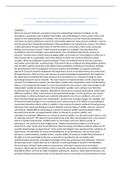Chapter Summary Social and Cross-cultural psychology
CHAPTER 2
What are research methods, and what is meant by methodology? Research methods are the
procedures a researcher uses to gather information, and methodology is a term used to refer to all
aspects of the implementation of methods. How do researchers test their theoretical predictions,
and where do these predictions come from? Information gathered using research methods is used to
test the researcher’s theoretical predictions. These predictions are derived from a theory. The theory
is often generated through observation of real-life events or by trying to make sense of puzzling
findings from previous research. What research strategies are available? We described three
quantitative research strategies: quasi-experiments, true randomized experiments and survey
research. Two key ways in which these strategies differ are in terms of (1) the degree to which one is
able to generalize to a population and (2) the degree to which one can draw inferences about
causality. What are qualitative research methods? These are methods that do not aim to provide,
and indeed cannot provide, numerical data. They tend to focus on textual and interpretative analysis,
and are often used by researchers who believe that quantitative methods are unsuited to studying
the phenomenon under investigation. Discourse analysis was identified as a popular qualitative
approach. Discourse analysis emphasizes the importance of how social phenomena are constructed
through discourse. What are the main features of social psychological experiments? We singled out
the experiment for detailed discussion because of its prominence as a research strategy in social
psychology during the last six decades. The main features of experimentation are the experimental
scenario; the independent variable; the dependent variable; the manipulation check; and debriefing.
What is a true experimental design? It is one that enables the researcher to infer that changes in the
independent variable produce changes in the dependent variable. Such a design must therefore
incorporate more than one condition, allowing the researcher to compare observations made under
different conditions. What is the minimal true experimental design? It is the post-test only control
group design, in which participants are randomly allocated to one of two conditions, only one of
which involves being exposed to the manipulation. Several more complex designs are available, and
of these the factorial design is very commonly used, mainly because of its ability to test predictions
concerning interaction effects. What is ‘validity’ in the context of research methods? Drawing strong
inferences from social psychological research depends on three types of validity: internal, construct
and external. Weidentified confounding as a threat to internal validity; social desirability effects,
demand characteristics and experimenter effects as threats to construct validity; and
volunteer/nonvolunteer differences as a threat to external validity. Can the Internet be used as a way
of collecting research? The Internet has provided social (and other) psychologists with a new arena in
which to conduct experiments, enabling them to reach larger and more diverse groups of
participants. The evidence to date suggests that, despite the potential problems of web-based
experiments, their results tend to parallel those obtained using conventional methods. What are the
possible disadvantages of experiments? Some social psychologists have questioned the usefulness of
experiments. We identified the cultural embeddedness of social behaviour, the fact that social
behaviour is determined by multiple factors, and the ability of humans to modify their behaviour in
the light of social psychological theories as grounds for questioning the assumption that
experimentation generates cumulative knowledge of the laws governing social behaviour. What are
the principal ways in which data can be collected in social psychological research? We identified
three principal methods: observational measurement, self-report measurement and implicit
measures. Observational and implicit measures have the advantage of being less susceptible to social
desirability effects, and can be made completely unobtrusive. However, observational measures are
obviously limited to phenomena that can be observed and are not suited to the assessment of covert
, cognitive phenomena such as attitudes, causal attributions and stereotypes (see Chapters 3, 6, 7 and
14). How can the ‘covert’ phenomena that are often of interest to social psychologists be studied? To
study such covert phenomena, researchers have traditionally relied on self-report measures,
although there has been an increasing tendency to make use of implicit measures, the goal of which
is to reveal phenomena that may either be outside the awareness of the individual or be misreported
in conventional self-report measures due to social desirability concerns. Can the different ways of
collecting data be used in conjunction? There are obvious advantages in using these different types
of measure in conjunction with each other. Do new ways of imaging brain activity have anything to
offer social psychology? Social psychologists and neuroscientists will make increasing use of
techniques such as brain imaging in the search for a better understanding of the neural
underpinnings of human social behaviour.
CHAPTER 3
CHAPTER SUMMARY How do we form impressions of what other people are like? Information
presented early in a sequence tends to be more influential (primacy effect), especially under time
pressure. Information regarding ‘central’ personality traits, such as warmth, is given more weight,
especially when it provides new and distinctive information. Do the same processes of person
perception operate when people meet face to face? Information transmitted nonverbally can have
more direct effects on impressions. We sometimes behave in ways that encourage other people to
conform to our impressions of them (selffulfilling prophecies). What is attribution theory? Attribution
theory tries to explain how people work out the causes of events, particularly events involving other
people. How do people draw conclusions about the motives and dispositions guiding deliberate
behaviour? According to correspondent inference theory, observers compare the effects of achosen
option with those of a rejected option. Non-common effects reveal the actor’s motivation and
corresponding disposition. How do people weigh up different possible causes? According to
covariation theory, lay perceivers conduct an informal statistical analysis to work out whether an
observed effect correlates with the person, entity, or context. What happens when there is
insufficient information for covariation analysis? People make use of prior knowledge about general
principles of causation (causal schemas) or about specific people, objects, and events when deciding
between possible causes. How do people explain their successes and failures? Weiner classified
perceived causes of success and failure using three dimensions: locus (whether the cause is internal
to the person or external), stability (whether the cause is stable or variable over time), and
controllability (whether the person can influence the cause). Attributing failure to internal, stable,
and uncontrollable causes reduces achievement motivation. Are certain patterns of attribution
associated with clinical depression? Clinically depressed people often attribute negative outcomes to
internal, stable and global (widely applicable) factors. Do attributions shape our own emotions?
Schachter believed that emotions depend on attributing experienced physiological arousal to
emotional situations. Although this is probably not true, the way that we interpret our emotions may
be influenced by manipulating our explanations for bodily symptoms. Are people more likely to
attribute behaviour to internal or external causes? In many situations, people from individualistic
cultures underestimate the impact of situational causes of another person’s behaviour
(correspondence bias). Why do people fall victim to correspondence biases? Situational information
may not be noticed, expectations about behaviour may distort interpretations, and people may not
have the motivation and opportunity to correct automatic dispositional inferences. Are
correspondence biases inevitable? Asking people to interpret the situation rather than the person
may reverse correspondence biases under cognitive load. People from collectivistic cultures seem
less susceptible to correspondence biases. Do people favour internal attributions for their own
behaviour? According to the actor– observer difference, people are more likely to use external
attributions for their own behaviour but internal attributions for other people’s behaviour. Are
attributions motivated by self-interest? Self-serving biases occur when people attribute positive
outcomes to internal factors and negative outcomes to external factors. Are attributions usually
inaccurate? Attributions usually lead to practically useful conclusions. Bias and error are probably







